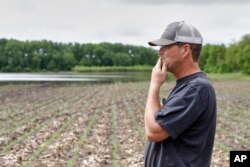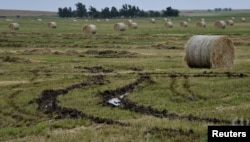The constant beat of rain upon the metal roof of Megan Dwyer’s barn on her rural Illinois farm is an all-too-familiar and unwelcome sound at this time of year.
“We picked up another 8/10ths (2 cm) last night,” she told VOA, competing to be heard over the noise created by the constant downpour on the barn. “We’ve probably picked up another 3 or 4 this morning.”
It has been one of the wettest planting seasons 30-year-old Dwyer has ever experienced.
“Ideally we’d like to be done planted with corn and have a good chunk of our beans in, and we’re maybe 5% planted in total right now,” she said.
And there’s no relief in sight.
One of the wettest 12 months
Continued rainfall across the Midwest extended a trend resulting in one of the wettest 12-month cycles on record in the United States. Prime farmland across the country continues to struggle with flooding and poor conditions for planting, among other issues.
At the end of May, Illinois farmers had about 35% of their crops planted, a dramatic contrast to an average of 95% in past years at the same time.
Dwyer is among many nationwide who have to make a decision soon — plant very late and hope it grows in time. Or, says Dwyer, “You’ve got the prevented plant option, which is where you don’t put a crop in at all.”
The “prevented plant option” is a crop insurance claim payout meant to help farmers deal with the loss of income because of poor planting weather, an option that is rarely used.
Stressful year gets more stressful
“People are trying to figure out how they’re going to make some money, how they’re going to pay the bills,” said Illinois Farm Bureau National Legislative Director Adam Nielsen. He added that the continued rainfall is creating a perfect economic storm for those already dealing with five consecutive years of negative farm income.
“It would be normally a very stressful year to begin with. But when you add the fact that we’re now entering year 2 of a trade war, and a lot of our markets are closed off to us, that adds a higher level anxiety right now. And that’s what our members are feeling,” he said.
The recent breakdown in trade negotiations between the United States and China has only added to Dwyer’s problems.
“Sixty percent of our soybeans get exported. For us, two-thirds of our soybeans, so more than that. And our end user is China, so there is a lot of uncertainty around where this product is going to go,” said Dwyer, who has been tending to the cattle on her farm in the time she has free because of the deluge that has left her farm soggy, muddy and bare.
“The rain on top of that, and the flooding, and not being able to get barges and river traffic through — nobody can even move the product, even if there was a buyer,” she said. “It’s pretty scary and uncertain times.”
Trump offer a dilemma
President Donald Trump’s promise to compensate farmers through another proposed U.S. Department of Agriculture aid package estimated at $16 billion this year may provide some relief for farmers.
“For me, I don’t want it,” Dwyer explained. “I’d rather have markets and access to a real place for my product to go.”
But Dwyer, like most farmers, is realistically left with little choice but to accept the aid to help make ends meet to help the farm survive to plant another day. But with the aid, comes stigma, Dwyer said.
“I’ve seen several comments, ‘Farmers are just looking for welfare.’ We’re looking for a handout. We’re waiting for the government to pay for us to do this. And that’s not at all what happens. We’re doing it so we can put food on our table, and have a crop and product to share with the rest of the country and the world,” she said.
But before there can be a product to share, there needs to be clear skies and warmth to dry out Dwyer’s fields so she can plant.
At least in the short term, the weather forecast isn’t providing much hope.











